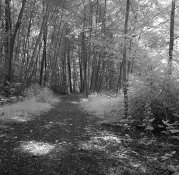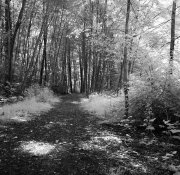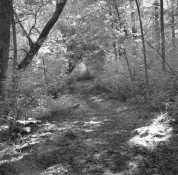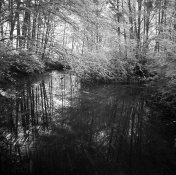One thing you can do with the Hoya R72 filter, which I also have, is to take it off the lens and hold it in both hands with your long fingers wrapped around the lens to your eye, blocking out as much white light as possible to, in effect, just be looking through the filter.
In bright sunlight, swing your self around looking at potential IR shots; you will certainly see where there is IR and where there is little or none. One thing though, keep your viewings through the filter in search of IR light shortish. Your eyes certainly start to adapt to the filter, I find a quick 5 second scan gives a good indication, then I zero in on where the IR is strongest. One then works out composition, and fires away.
Bright green leaves on northern hemisphere trees in certain angled sunlight will show up as nearly white, that means there is bulk IR radiating onto them and that it is visible in the direction you are looking. This means you can shoot in that direction and if your filtering is correct, you should be able to record in or near the IR part of the spectrum and block out most but not all of the visible part of the spectrum
Water will almost always look black and high level fleecy/stringy clouds will often look very interesting looking in the right direction. Low clouds dont look very well at all; in fact on low cloud days with IR film and filters, its pretty much a waste of effort and materials in my experience.
Finding IR radiation is a primary requirement, photographing the objects in that light, is the secondary requirement; both are reasonably easy to do.
IR photography with the old Kodak film really worked out very well using this pre-visualising technique.
If you are using short focal length lenses, 20mm, 24mm or 28mm, then you can usually hand hold and fire away and crop in the darkroom. Longer focal length lenses are generally a tripod job to ensure you point the camera pretty much where you want, your call.
Mick.








 .
.





